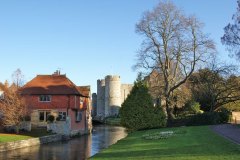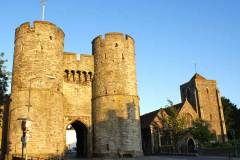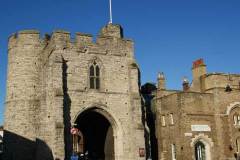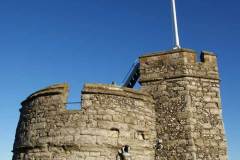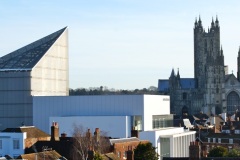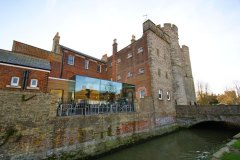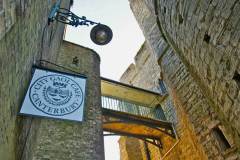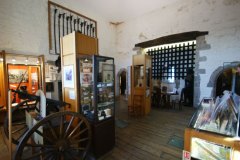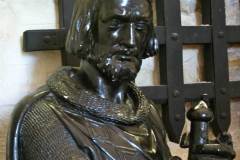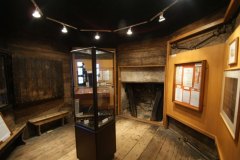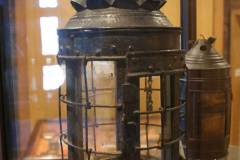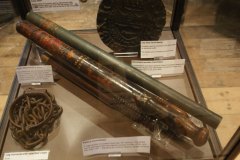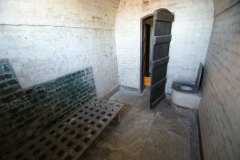St Dunstan’s Street / Pound Lane
Introduction
Westgate is the largest surviving medieval gate in England and visitors can still enter the city through its arch as they have done since the mid 1380s. However, from late 2011 the city council are consulting on proposals to restrict access to buses and taxis only. (Note: not followed up – at present open to all traffic, 2020)
History
The first gate was built here between 270-290 AD when the Romans decided to exploit the river as a natural defence. In later Anglo-Saxon times the guard chamber above accommodated the church of the Holy Cross. In 1379 the Holy Cross church was moved to the adjacent site it now occupies and the the current gate was built as part of the strengthening of the city walls to counter the threat of a French invasion during the Hundred Years War. It was partly funded by Archbishop Simon Sudbury, Chancellor of England, who was responsible for raising the punitive Poll Tax to fund the war. He was murdered at the Tower of London during the Peasants’ revolt against the tax in 1381. It was completed in the mid 1380s as the largest of the city’s medieval gates and the design, probably by the King’s master mason Henry Yevele, and was the first specifically built for defence to include gun loops in England.
In 1453 Henry VI permitted the city to keep a gaol at the Westgate, while Canterbury Castle remained the county gaol. The current perpendicular east window was added around 1491 to provide light into the guardhouse. Access to the city through the gate was over a drawbridge until the mid 16th century when it was replaced by a substantial twin-arched crossing of Kentish ragstone. In 1648 Oliver Cromwell’s Parliamentarians burnt down the wooden gates in response to riots in the city over the banning of Christmas Day, which also led to demolition of the wall from Westgate to the Castle. The wooden gates were replaced in 1660 and they continued to be closed at nights until their final removal in 1785. In 1793 the wooden cell doors and linings (which can still be seen today) were also installed.
Between 1823-29 the prison was deemed inadequate so the remaining short sections of wall attached to the drum towers were removed and the current Pound Lane gaol and the high level connecting bridge were constructed. At the same time St Peter’s Place was created and the bridge widened to allow an additional route around the gate. In 1865 the Victorian Prison Act led to closure of the gaol (closure completed in 1868) after only forty years and the Pound Lane gaol was converted to a police station. The city council took back Westgate for storage of archives in 1870, opened it to summer visitors in 1878 and as a museum in 1906. Pound Lane Police Station was closed in 1965 and East Kent Music School opened there by Ted Heath (future prime minister) the following year.
In 2009 the museum was under threat of closure by the council but funding was provided for two years in order to seek solutions with other organisations. As a result Westgate Towers Museum was re-opened in April 2011 under the directorship of the late Charles Lambie who refurbished and extended the museum to include the adjoining former 1830s gaol and a cafe. The present owners (One Pound Lane Ltd.) opened the Pound bar and kitchen in December 2014.
What to see:
- The picturesque view from Westgate Gardens along the River Stour with an extensively renovated old mill in the foreground (Image 1).
- The view from St. Dunstan’s Street of Westgate and Holy Cross church. The revolutionary design of the gate included 60 foot drum towers of Kent ragstone, 18 gun loops, a portcullis, battlements, machicolations (for for dropping burning oil etc on to attackers) and battered (sloping) plinths into the river (Image 2).
- The view from St Peter’s Street showing the three floor construction, the vaulted passageway into which the portcullis could be lowered, the connecting bridge and mock gun loops. The old gaol and city police station extend down Pound Lane (Image 3).
- The tower on top of the north drum with a wind vane cut out to form a date of 1846 and the initials of Henry Cooper, who was elected mayor for the fourth time in 1845 (Image 4).
- The view from the battlements of the north drum of the cathedral and the new Marlowe theatre opened in autumn 2011 (Image 5).
- The view across the river from North Lane showing the old gaol clad in stone to match the Westgate and the paved exercise area, now enclosed with glass for the bar seating area (Image 6).
- The connecting bridge, now enclosed in glass (Image 7).
Westgate Museum:
- The museum in the the guardroom with a replica portcullis and an exhibition of armaments and weapons from the English Civil War to World War II (Image 8).
- Maquettes (artists’ scale models) of bronze statues of the Barons of England at the time of the Magna Carta. The final versions can be seen in the House of Lords in London. Archbishop Stephen Langton was highly influential in the drafting and signing of the treaty (Image 9).
- The interior of of the cell in the north drum (Image 10), now containing the history of the goal and police station and many artefacts including an early 19th century night watchman’s lantern (Image 11) and policeman’s truncheons (Image 12).
- An original cell in the Pound Lane gaol can sometimes been seen (visitors booking an Escape Room game, Image 13).
- A modern reproduction toilet suite by Thomas Crapper, who popularised the modern flush toilet in the second half of the 19th century, installed in the cafe toilets (Image 14).
Access: The buildings can be viewed externally at all times and the museum is usually open on weekday afternoons (noon onwards).
Sources: Lyle (2008); Tatton-Brown (1994)

